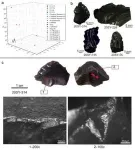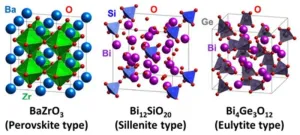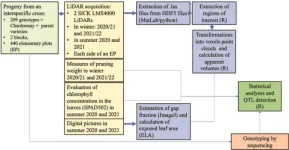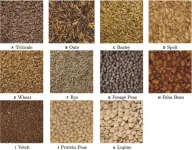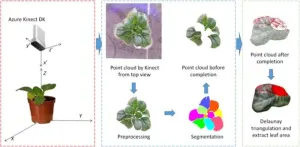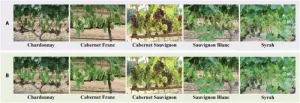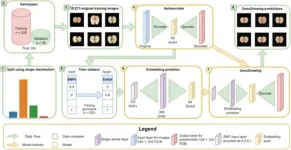Light it up: reimagining the optical diode effect
Discovery of a material with a large nonreciprocal absorption of light that differs by a factor of two or more when the direction of light propagation is reversed
2024-01-18
(Press-News.org)
Osaka, Japan – At the heart of global internet connectivity, optical communications form an indispensable foundation. Key to this foundation are optical isolators, created by combining multiple components. The result is a complex structure that transmits light in only one direction, to prevent damage to lasers and minimize noise by avoiding the reversal of light. However, some magnetic materials have an optical diode effect – an unconventional nonreciprocal absorption of light manifested by the material itself. This effect leads to a change in transmittance depending on the direction in which the light travels. If this phenomenon can be enhanced, it is expected that optical isolators can be made more compact and efficient.
A team of researchers led by Associate Professor Kenta Kimura of the Graduate School of Engineering at Osaka Metropolitan University investigated the phenomenon of nonreciprocal optical absorption in the magnetoelectric antiferromagnet LiNiPO4 at shortwave infrared wavelengths. Their results showed that the absorption coefficient differs by a factor of two or more when the direction of light propagation is reversed. This large nonreciprocal absorption is attributed to the magnetic properties of the divalent nickel (Ni2+) ions. Furthermore, the researchers have shown that it is possible to switch the optical diode effect with an applied magnetic field in a non-volatile manner.
“The optical diode effect is an interesting subject of study because it is such an unconventional phenomenon that is far removed from common sense and has the potential to realize unexpected applications. However, there are still many problems at present, such as the low operating temperatures,” explained Professor Kenta Kimura. “Nevertheless, this research has demonstrated the usefulness of compounds containing nickel, which has greatly expanded the scope of material selection. Based on this knowledge, we will continue the development of materials exhibiting a higher performance optical diode effect.”
Their findings were published in Physical Review Letters.
###
About OMU
Osaka Metropolitan University is the third largest public university in Japan, formed by a merger between Osaka City University and Osaka Prefecture University in 2022. OMU upholds "Convergence of Knowledge" through 11 undergraduate schools, a college, and 15 graduate schools. For more research news visit https://www.omu.ac.jp/en/ or follow us on Twitter: @OsakaMetUniv_en, or Facebook.
END
ELSE PRESS RELEASES FROM THIS DATE:
2024-01-18
Fukuoka, Japan – Researchers at Kyushu University, in collaboration with Osaka University and the Fine Ceramics Center, have developed a framework that uses machine learning to speed up the discovery of materials for green energy technology. Using the new approach, the researchers identified and successfully synthesized two new candidate materials for use in solid oxide fuel cells – devices that can generate energy using fuels like hydrogen, which don’t emit carbon dioxide. Their findings, which were reported in the journal, ...
2024-01-18
In response to the pressing need to reduce pesticide usage and adapt grapevine varieties to climate change, there's an unprecedented effort to phenotype new genotypes using high-throughput methods. Teams globally are developing advanced systems, employing technologies like multispectral cameras and LiDAR, to assess growth traits, photosynthetic capability, and other architectural parameters. However, traditional methods remain time-consuming and less efficient for large-scale studies. The current research gap lies in effectively employing LiDAR technology ...
2024-01-18
Cultivating seed mixtures for local pastures is an age-old method to produce cost-effective and balanced animal feed, enhancing agricultural autonomy and environmental friendliness in line with evolving European regulations and organic consumer demands. Despite its benefits, farmers face adoption challenges due to the asynchronous ripening of cereals and legumes and the difficulty in assessing the nutritional value of heterogeneous seeds. Current practices rely on informal, empirical methods, and a proposed solution is to develop a mobile app or online service, similar to Pl@ntNet, for automated nutritional evaluation of seed mixtures, ...
2024-01-18
The 3-dimensional point cloud technology revolutionizes non-invasive measurement of plant phenotypic parameters, offering vital data for agriculture and research. Current research focuses on overcoming the limitations of 2.5D imaging and occlusions. Methods such as structure from motion, multi-view stereo, and advanced active 3D reconstruction techniques are being explored for this purpose. However, issues persist with incomplete data acquisition and the inaccuracy of phenotypic parameter extraction due ...
2024-01-18
To improve grape yield predictions, automated berry counting has emerged as a crucial yet challenging task due to the dense distribution and occlusion of berries. While grape cultivation is a significant global economic activity, traditional manual counting methods are inaccurate and inefficient. Recent research has shifted towards deep learning and computer vision, employing detection and density estimation techniques for more precise counts. However, these methods grapple with the variability of farmland and high occlusion rates, leading to significant counting errors. Additionally, creating high-performance ...
2024-01-18
Advancements in whole-genome sequencing have revolutionized plant species characterization, providing a wealth of genotypic data for analysis. The combination of genomic selection and neural networks, especially deep learning and autoencoders, has emerged as a promising method for predicting complex traits from this data. Despite the success in applications like plant phenotyping, challenges remain in accurately translating visual information from images into measurable data for genomic studies.
In November 2023, Plant ...
2024-01-18
Erin Overstreet has been selected as the new executive director of the USC Stevens Center for Innovation where she will oversee the university’s commercialization of USC-driven intellectual property.
Overstreet’s expertise and experience embody technology transfer and innovation across the academic, educational, and venture capital sectors; such experience is critical for bridging USC research to a broadened, national technology transfer ecosystem, said Ishwar Puri, senior vice president of the Office of Research and Innovation.
“The university has the utmost confidence in Dr. Overstreet’s ability to ...
2024-01-18
In the field of Landscape Architecture, Topography aims to study the complex and ongoing changing relationship between humans and the land through continuously updated and iterative tools and media. It maintains a balance between abstract concepts and concrete perceptions, which can both drive the development of science and technology in this field and hold on to openness to artistic expression. Thus, topographical design may be an effective way to help facilitate refining landscape design methods.
The work entitled “Can Topography ...
2024-01-18
Associate Professor Andrew Baker from QUT School of Biology and Environmental Science said antechinuses are carnivorous marsupials well-known for suicidal sex sessions where all males die after the 1 to 3 week breeding period.
“During the breeding season, male and females mate promiscuously in frenzied bouts lasting as long as 14 hours. Certain stress-induced death follows for all males as surging testosterone causes cortisol to flood uncontrolled through the body, reaching pathological levels,” Professor Baker said.
“The males drop dead, which provides an opportunity ...
2024-01-18
Protecting the world’s oceans against accelerating damage from human activities could be cheaper and take up less space than previously thought, new research has found.
The University of Queensland’s Professor Anthony Richardson collaborated on the study, which looks to halt the rapid decline of marine biodiversity from expanding industrial activities in marine areas beyond national jurisdictions (ABNJ).
“This ‘blue acceleration’ as we call it, has seen a greater diversity of stakeholders interested in ABNJs, such as the high seas and the international seabed beyond exclusive economic zones,” ...
LAST 30 PRESS RELEASES:
[Press-News.org] Light it up: reimagining the optical diode effect
Discovery of a material with a large nonreciprocal absorption of light that differs by a factor of two or more when the direction of light propagation is reversed


